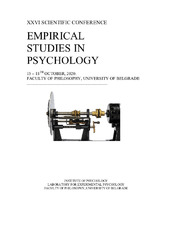| dc.description.abstract | The aim of the study was to systematically assess the occurrence and age-related increase of
functional words and specific grammatical parameters in the early language of Serbian
children between 8 and 30 months of age based on the adapted version of MacArthur-Bates’
Communicative Development Inventories (CDIs). The sample included 126 mothers
assessing their child’s language by means of the CDI-1 for ages 8-18 months, and CDI-2 for
ages 16-30 months. The first questionnaire registers the occurrence of early grammatical
words (pronouns, interrogatives, prepositions). The second is intended to evaluate the
acquisition of the complex grammatical system: pronouns, prepositional constructions, noun
morphology, modal and auxiliary verbs, conjugation, tense, negation, indicators of length and
complexity of utterances.
The results of the CDI-1 reveal the occurrence of early grammatical words at the age of 13 to
15 months: pronouns to 'this', moj/moja/moje ‘my’, and mene/me ‘me’, and the preposition o
‘on, about’. The first Wh-questions gde ‘where’ and kada ‘when’ appear at the same age. A
larger variety of grammatical words in the sample was recorded at the age of 16 to 18
months: 9 pronouns out of 14 from the list are recorded, 11 prepositions (out of 12 from the
list), as well as the first occurrence of the Wh-questions šta ’what’ and zašto ‘why’.
Significant increase was recorded in CDI-2 for the following morpho-syntactic categories
(five age groups in the range of 16-30 months, p<0.05): diminutive, possessive adjective,
verb person, regular and irregular plural of nouns, preposition-case construction, negative
verb forms, present and past tense, while the future tense is not mastered even at the older age
levels. The longest utterance increases with age and reaches a length of 5.3 words at 25-27
months of age. The evidence of utterance complexity is recorded in the use of modal verbs,
possessive pronouns, possessive adjectives, Wh-questions, dependent clause, direct vs.
indirect object, utterance extension. Some aspects of complexity are not mastered even by
older age levels (e.g. causative and relational conjunctions). The data obtained on the CDI-2
reveal that a more intensive acquisition of grammar starts at 22 to 24 months of ages,
The obtained results indicate a systematic increase in all functional words and parameters of
grammar. Additionally, it provides a preliminary confirmation of the validity of CDIs for the
assessment of early grammatical development of children. | sr |

